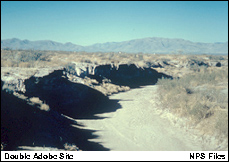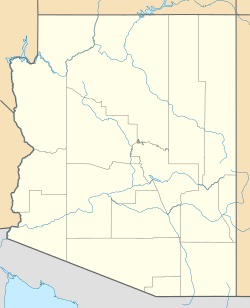Double Adobe site facts for kids
|
Double Adobe site
|
|
 |
|
| Nearest city | Douglas, Arizona |
|---|---|
| NRHP reference No. | 66000169 |
Quick facts for kids Significant dates |
|
| Added to NRHP | October 15, 1966 |
| Designated NHL | January 20, 1961 |
The Double Adobe site is an important archaeological site in southern Arizona. It is located about twelve miles northwest of Douglas, in an area called Whitewater Draw. This site helps us learn about ancient people and animals that lived in the Southwest long ago.
Contents
Discovering the Past
In October 1926, a team from the University of Arizona began exploring the Whitewater Draw area. This team was led by Byron Cummings, who was the first head of the Archaeology Department at the university. One of his students on this trip was Emil Haury, who later became a very famous archaeologist.
A Schoolboy's Find
The Double Adobe site was first found by a schoolboy. What he discovered was amazing: a mammoth skull lying on top of a layer of sand. In that sand, there were also ancient stone tools. This showed that humans and mammoths had lived in the same place.
What Scientists Found
Later, more scientists studied the site. They found that ancient river floods had mixed the bones and tools together. This made it a bit tricky to understand how everything was originally placed.
Scientists found fossil bones from many different animals. These included huge mammoths, horses, bison, antelope, coyotes, and even dire wolfs. Along with these bones, they found human tools. These tools included rocks that had been cracked by fire, sharp projectile points (like spear tips), and small grinding stones.
Life After the Ice Age
The discovery of grinding stones at Double Adobe is very important. It suggests that people were starting to change how they lived. This was happening as the Ice Age was ending. Many large animals, like mammoths, were disappearing during an event called the Quaternary extinction event.
A Changing Climate
Around 10,000 years ago, the Holocene Era began. This brought warmer and drier weather to the Southwest. Because of these changes, the way people lived also changed.
The Clovis culture, known for its distinctive spear points, began to fade. New ways of life, called the Archaic cultures, started to appear. These cultures were more adapted to the new environment.
The Cochise Culture
The Double Adobe site is a key part of understanding the Cochise culture. This name was given to the Archaic traditions in the southern Southwest. Famous archaeologists like E. B. Sayles and E. Antevs used discoveries from the Double Adobe area to define this culture in 1941.
Over the years, many respected archaeologists have studied this region. The Double Adobe site has given us valuable information. It helps us understand the ancient climate, ecology (how living things interact with their environment), and animal life in southern Arizona.
A Special Landmark
Because of its great importance, the Double Adobe site was named a National Historic Landmark in 1961. This means it is a place of national historical significance.



